Telescope Reviews
Page 15
By Ed Ting
Updated 5/25/02
Click on a Telescope Below:
1) Starmaster 12.5" EL Dobsonian
2) Celestron G8N Newtonian
3) Takahashi FCT150 Refractor
4) Megrez 80 mm f/6 Refractor
1) Starmaster 12.5" EL Dobsonian 1/12/01, 5/25/02
(12.5" f/5 Dobsonian Reflector, $2895 + $175 shipping)
(New versions are f/4.5)
Another winner from Starmaster.
At first, the 12.5" EL looks just like its siblings, the 10" and the 11"
units, but this one is slightly different. The rocker box is a little
larger and heavier, the side bearings are bigger, and the mirror cell is
a 9-point floatation-type (the 10" and 11" ELs used conventional 3-point
cells.)
All of this conspires to tip the 12.5" EL's weight in at 79 lbs, which
is getting up there (the 11" weighs 70 lbs.) You need to take this into
consideration if you plan to move the scope a lot. Those extra 9 lbs
can feel like a lot in the middle of the night in sub-freezing weather.
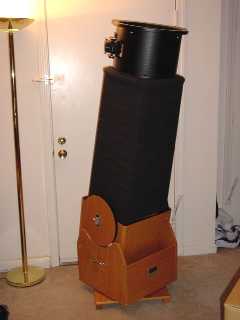 Another impressive entry within
the EL line: Starmaster's 12.5"
The biggest difference with this model is that uses a Paracorr as an
integral part of its design. I briefly tried using the scope without the
Paracorr - some eyepieces would not come to focus, and the scope
became back-heavy. You really do need the Paracorr in place, and
that's how I used it.
I admit I've been programmed to dislike these lens-in-drawtube arrange-
ments (due, no doubt, to scopes at the cheap end of the market that use
them - bleah!) but in this case the Paracorr is, for all intents and purposes,
invisible under normal use. Even with low power eyepieces in place, the
field is sharp from edge to edge.
The mirror is another beauty - I've seen so many outstanding Zambuto
mirrors lately that I've run out of superlatives to describe them. The
bearings are silky smooth industrial velcro-on-teflon, which allows you
to comfortably hand-track at powers much higher than you might normally
think. The secondary assembly is a new design from Starmaster with a
wooden ring at the end.
I used the scope on a cold winter's night at a star party recently. The
views were gorgeous - bright, contrasty, and tack-sharp. Planetary detail
is stunning during times of good seeing. Here in the Northeast, 12.5" is a
little too much for serious planetary work most of the time, but if you
live in the dry, steady Southwest you are going to be in heaven. I spent
an enjoyable evening looking at M31, M33, NGC7331/Stephan's, M15, M13,
M57, M13, M92, and many others. After a couple of hours of this, I found
myself wanting this telescope, even though I already own the 10" version.
With the 10" EL discontinued, your choice has become a little easier.
The 11" EL is more of a general purpose portable Dob; the 12.5" adds
1/2 magnitude and $500 but is more of a chore to lug around. The waiting
lists for both are still reasonable, in the 4-6 month range. Either unit is
highly recommended for amateurs looking for a premium Dobsonian. Your
move.
Update, 5/25/02: New versions are f.4.5, which will allow for seated
observing.
2) Celestron G8N 1/31/01
(8" f/5 hybrid Newtonian, CG5 mount, 8X50 finder, about $800 street)
Celestron seems to be enamored with these hybrid Newtonians. Back in
the 1980's they had a series of "Comet" reflectors with corrector lenses
in the drawtubes. To be charitable, these were unexceptional telescopes.
Now Celestron is back at it again with the C150HD and G8N Newtonians.
The newer designs, sourced from a Chinese factory, use a corrector lens
assembly in front of the secondary mirror. This arrangement raised
eyebrows with everyone I talked to. These lenses are supposed to correct
for coma and other aberrations on fast Newtonians but often wind up
causing problems of their own. Club members who looked through
this G8N often wondered out loud why Celestron can't just make "normal"
Newtonians without the silly corrector lenses.
Another impressive entry within
the EL line: Starmaster's 12.5"
The biggest difference with this model is that uses a Paracorr as an
integral part of its design. I briefly tried using the scope without the
Paracorr - some eyepieces would not come to focus, and the scope
became back-heavy. You really do need the Paracorr in place, and
that's how I used it.
I admit I've been programmed to dislike these lens-in-drawtube arrange-
ments (due, no doubt, to scopes at the cheap end of the market that use
them - bleah!) but in this case the Paracorr is, for all intents and purposes,
invisible under normal use. Even with low power eyepieces in place, the
field is sharp from edge to edge.
The mirror is another beauty - I've seen so many outstanding Zambuto
mirrors lately that I've run out of superlatives to describe them. The
bearings are silky smooth industrial velcro-on-teflon, which allows you
to comfortably hand-track at powers much higher than you might normally
think. The secondary assembly is a new design from Starmaster with a
wooden ring at the end.
I used the scope on a cold winter's night at a star party recently. The
views were gorgeous - bright, contrasty, and tack-sharp. Planetary detail
is stunning during times of good seeing. Here in the Northeast, 12.5" is a
little too much for serious planetary work most of the time, but if you
live in the dry, steady Southwest you are going to be in heaven. I spent
an enjoyable evening looking at M31, M33, NGC7331/Stephan's, M15, M13,
M57, M13, M92, and many others. After a couple of hours of this, I found
myself wanting this telescope, even though I already own the 10" version.
With the 10" EL discontinued, your choice has become a little easier.
The 11" EL is more of a general purpose portable Dob; the 12.5" adds
1/2 magnitude and $500 but is more of a chore to lug around. The waiting
lists for both are still reasonable, in the 4-6 month range. Either unit is
highly recommended for amateurs looking for a premium Dobsonian. Your
move.
Update, 5/25/02: New versions are f.4.5, which will allow for seated
observing.
2) Celestron G8N 1/31/01
(8" f/5 hybrid Newtonian, CG5 mount, 8X50 finder, about $800 street)
Celestron seems to be enamored with these hybrid Newtonians. Back in
the 1980's they had a series of "Comet" reflectors with corrector lenses
in the drawtubes. To be charitable, these were unexceptional telescopes.
Now Celestron is back at it again with the C150HD and G8N Newtonians.
The newer designs, sourced from a Chinese factory, use a corrector lens
assembly in front of the secondary mirror. This arrangement raised
eyebrows with everyone I talked to. These lenses are supposed to correct
for coma and other aberrations on fast Newtonians but often wind up
causing problems of their own. Club members who looked through
this G8N often wondered out loud why Celestron can't just make "normal"
Newtonians without the silly corrector lenses.
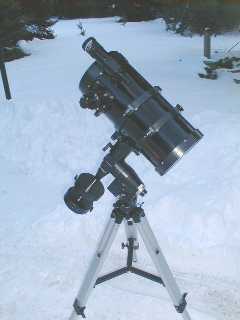 Celestron's new G8N
The scope is incredibly short (20 inches) for its focal length. At first
glance it looks like one of Celestron's 8" Schmidt-Cassegrains. The short
tube makes for steadier views on the CG5 mount (a clone of the venerable
Super/Great Polaris) although the views over 100X or so were a little less
steady than I prefer at this level. Readers should also be aware that the
dovetail plate on the G8N is much shorter than the 160 mm plate on the
SP/GP and most other CG5s. The hole spacing is closer to 125 mm to
accomodate the ultra-short tube.
The secondary assembly is big and beefy, and extends like a baffle down
the tube. The lens - presumably a doublet - looks as if it has decent coatings.
As a result of the weight, the 4 secondary vanes are much thicker than
normal. This tends to screw up the star test patterns a bit but the thicker
vanes actually throw up smaller diffraction spikes on bright stars (counter-
intuitively, thinner vanes throw up brighter diffraction spikes.)
The 2" focuser is very smooth and has nice big teflon pads inside. The 8X50
finder is also of good quality and has the "sprung" third leg on its bracket.
There's a large plate on the back of the scope that effectively seals it shut;
removing it exposes the mirror and the (inconvenient) push-pull cells. There's
another cover for the secondary's adjustment screws. The mount had tight
tolerances and needed both counterweights to balance out the tube.
These are odd telescopes. I did not know what to expect - previous hybrids
from Celestron have been unremarkable, and reports from owners of the C150HD
(the scope's 6" smaller brother) have been mixed.
I used the scope over a few nights in mid January 2001 under reasonably
dark skies. The star test shows modest undercorrection, nothing serious.
And yes, there is a trace of false color around bright objects; the corrector
lens is not apochromatic. The color is fairly benign until you pump up
the power on something bright like Jupiter. Over 125X or so, it becomes
intrusive and the view starts to resemble that of a cheap achromat.
Jupiter showed four moons and had decent detail in the cloud bands at
125X. Cassini's Division on Saturn was detected, but not as crisply as
I'm accustomed to. Also, the views on planets tended to be slightly better
when the object was placed away from the center of the field of view -
you can actually see the image sharpen up as it moves out of the area
of the central obstruction.
The Pleiades and M42 looked sharp and bright at 37X with a 27 mm Panoptic.
But at these low powers, there was minor edge distortion and contrast loss
near the field stop. Nothing too serious, but it was noticeable. For balance
I should state that I looked at M33 and was able to see the H-Alpha region
with little difficulty. However, the sky background was blacker in refractors
and other Newtonians I had nearby.
To see how the scope performed in absolute terms, I compared it to the
Traveler and the 10" EL Starmaster. Both premium scopes walked all over
the inexpensive G8N. The refractor made the planets sharper, with more
low-level detail. And the commerical-grade mirror in the G8N was no match
for the Zambuto unit in the Starmaster. But the G8N's optics are decent and
serviceable.
I used the scope over a few nights, and club various members stopped by to
look through it. The words "decent" and "acceptable" kept cropping up in
conversation and in my observing notes. My personal feelings about it are
still mixed. On the one hand, its images aren't bad, and it is better than
any Schmidt-Newtonian I've ever used, for example. On the other hand,
any decent mid-quality Dob will beat it optically for a lot less money. If I
wanted an 8" Celestron, I think I'd get one of the Schmidt-Cassegrains, or
the 8" Starhopper Dobsonian. If I were ranking this in my matrix, I'd put
it somewhere in the (2+) region.
Marginally recommended if you like this sort of thing.
3) Takahashi FCT150 3/30/01, 2/20/02
(6" f/7 fluorite triplet refractor, OTA only, $17,995 list, about $15,000-$16,000 street)
(Note: Please read related article)
Roughly speaking, people reading Scopereviews fall into three broad categories:
1) Shoppers earnestly looking for reviews and comparisons of equipment they plan
to buy, 2) Browsers who get a kind of simple pleasure out of reading my geeky
ramblings, and 3) Dreamers looking for the latest news on absurdly rare and
expensive equipment that no sane person is ever likely to own. The FCT150 is
for people in the latter category.
Think about this for a moment. Eighteen Big Ones for a telescope optical tube
assembly. Add the mount, finder(s), diagonal, eyepieces, etc and you could easily
be set back another $10,000. The FCT150 telescope is worth more than my car.
This sample was purchased by Todd Gross, who let me play with it for about while
he was busy searching for a suitable mount. While I deeply appreciated the gesture
from Todd, it scared the bejeesus out of me knowing this thing was lying around the
house.
Celestron's new G8N
The scope is incredibly short (20 inches) for its focal length. At first
glance it looks like one of Celestron's 8" Schmidt-Cassegrains. The short
tube makes for steadier views on the CG5 mount (a clone of the venerable
Super/Great Polaris) although the views over 100X or so were a little less
steady than I prefer at this level. Readers should also be aware that the
dovetail plate on the G8N is much shorter than the 160 mm plate on the
SP/GP and most other CG5s. The hole spacing is closer to 125 mm to
accomodate the ultra-short tube.
The secondary assembly is big and beefy, and extends like a baffle down
the tube. The lens - presumably a doublet - looks as if it has decent coatings.
As a result of the weight, the 4 secondary vanes are much thicker than
normal. This tends to screw up the star test patterns a bit but the thicker
vanes actually throw up smaller diffraction spikes on bright stars (counter-
intuitively, thinner vanes throw up brighter diffraction spikes.)
The 2" focuser is very smooth and has nice big teflon pads inside. The 8X50
finder is also of good quality and has the "sprung" third leg on its bracket.
There's a large plate on the back of the scope that effectively seals it shut;
removing it exposes the mirror and the (inconvenient) push-pull cells. There's
another cover for the secondary's adjustment screws. The mount had tight
tolerances and needed both counterweights to balance out the tube.
These are odd telescopes. I did not know what to expect - previous hybrids
from Celestron have been unremarkable, and reports from owners of the C150HD
(the scope's 6" smaller brother) have been mixed.
I used the scope over a few nights in mid January 2001 under reasonably
dark skies. The star test shows modest undercorrection, nothing serious.
And yes, there is a trace of false color around bright objects; the corrector
lens is not apochromatic. The color is fairly benign until you pump up
the power on something bright like Jupiter. Over 125X or so, it becomes
intrusive and the view starts to resemble that of a cheap achromat.
Jupiter showed four moons and had decent detail in the cloud bands at
125X. Cassini's Division on Saturn was detected, but not as crisply as
I'm accustomed to. Also, the views on planets tended to be slightly better
when the object was placed away from the center of the field of view -
you can actually see the image sharpen up as it moves out of the area
of the central obstruction.
The Pleiades and M42 looked sharp and bright at 37X with a 27 mm Panoptic.
But at these low powers, there was minor edge distortion and contrast loss
near the field stop. Nothing too serious, but it was noticeable. For balance
I should state that I looked at M33 and was able to see the H-Alpha region
with little difficulty. However, the sky background was blacker in refractors
and other Newtonians I had nearby.
To see how the scope performed in absolute terms, I compared it to the
Traveler and the 10" EL Starmaster. Both premium scopes walked all over
the inexpensive G8N. The refractor made the planets sharper, with more
low-level detail. And the commerical-grade mirror in the G8N was no match
for the Zambuto unit in the Starmaster. But the G8N's optics are decent and
serviceable.
I used the scope over a few nights, and club various members stopped by to
look through it. The words "decent" and "acceptable" kept cropping up in
conversation and in my observing notes. My personal feelings about it are
still mixed. On the one hand, its images aren't bad, and it is better than
any Schmidt-Newtonian I've ever used, for example. On the other hand,
any decent mid-quality Dob will beat it optically for a lot less money. If I
wanted an 8" Celestron, I think I'd get one of the Schmidt-Cassegrains, or
the 8" Starhopper Dobsonian. If I were ranking this in my matrix, I'd put
it somewhere in the (2+) region.
Marginally recommended if you like this sort of thing.
3) Takahashi FCT150 3/30/01, 2/20/02
(6" f/7 fluorite triplet refractor, OTA only, $17,995 list, about $15,000-$16,000 street)
(Note: Please read related article)
Roughly speaking, people reading Scopereviews fall into three broad categories:
1) Shoppers earnestly looking for reviews and comparisons of equipment they plan
to buy, 2) Browsers who get a kind of simple pleasure out of reading my geeky
ramblings, and 3) Dreamers looking for the latest news on absurdly rare and
expensive equipment that no sane person is ever likely to own. The FCT150 is
for people in the latter category.
Think about this for a moment. Eighteen Big Ones for a telescope optical tube
assembly. Add the mount, finder(s), diagonal, eyepieces, etc and you could easily
be set back another $10,000. The FCT150 telescope is worth more than my car.
This sample was purchased by Todd Gross, who let me play with it for about while
he was busy searching for a suitable mount. While I deeply appreciated the gesture
from Todd, it scared the bejeesus out of me knowing this thing was lying around the
house.
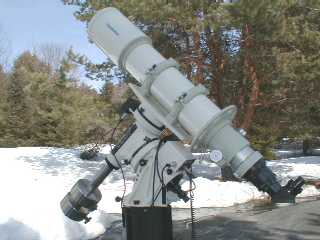 Don't tell your wife how much it costs:
Takahashi's magnificent FCT150
(Mount: AP900)
Mechanically, the FCT150 bears a superficial resemblance to the FS152. The
FS152 is a conventional doublet, while the FCT is a triplet. Theoretically, a three-
lens design allows you to correct for aberrations more easily than a two-lens
design, but at additional cost. These older FC-series models featured an uncoated
fluorite element (the newer FS series have multi-coatings on the fluorite element.)
Shining a flashlight down the tube does reveal two reflections that are slightly
brighter than the others. This, coupled with the fact that the scope is an air
spaced triplet, led to speculation that the contrast might not be up to modern
standards.
If you think about the fact that the FS152 already sells for $10,000, it would
seem that you are paying $8000 for one additional chunk of glass in this FCT150.
But it's not so simple. Any resemblance to the FS152 is purely coincidental.
The FCT150 is a completely different animal. Despite being about six inches
shorter, it weighs twice what the FS152 does at nearly 50 lbs. The scope
feels like a solid chunk of iron when you pick it up.
The FCT150 is the most physically beautiful telescope I have ever seen. Looking
the scope over, it starts becoming obvious that this isn't just another Takahashi
refractor, great as they already are. Everyone who came over during the review
period remarked on its stunning appearance. This FCT has a level of detail
lavished upon it that suggests the product was a labor of love for someone at
the factory. The fit and finish are extraordinary. Sliding off the silky-smooth
dust cap, or racking the focuser in and out, become sensual tasks. One club
member, after touching the scope, remarked, "I'm never washing this hand again."
Don't tell your wife how much it costs:
Takahashi's magnificent FCT150
(Mount: AP900)
Mechanically, the FCT150 bears a superficial resemblance to the FS152. The
FS152 is a conventional doublet, while the FCT is a triplet. Theoretically, a three-
lens design allows you to correct for aberrations more easily than a two-lens
design, but at additional cost. These older FC-series models featured an uncoated
fluorite element (the newer FS series have multi-coatings on the fluorite element.)
Shining a flashlight down the tube does reveal two reflections that are slightly
brighter than the others. This, coupled with the fact that the scope is an air
spaced triplet, led to speculation that the contrast might not be up to modern
standards.
If you think about the fact that the FS152 already sells for $10,000, it would
seem that you are paying $8000 for one additional chunk of glass in this FCT150.
But it's not so simple. Any resemblance to the FS152 is purely coincidental.
The FCT150 is a completely different animal. Despite being about six inches
shorter, it weighs twice what the FS152 does at nearly 50 lbs. The scope
feels like a solid chunk of iron when you pick it up.
The FCT150 is the most physically beautiful telescope I have ever seen. Looking
the scope over, it starts becoming obvious that this isn't just another Takahashi
refractor, great as they already are. Everyone who came over during the review
period remarked on its stunning appearance. This FCT has a level of detail
lavished upon it that suggests the product was a labor of love for someone at
the factory. The fit and finish are extraordinary. Sliding off the silky-smooth
dust cap, or racking the focuser in and out, become sensual tasks. One club
member, after touching the scope, remarked, "I'm never washing this hand again."
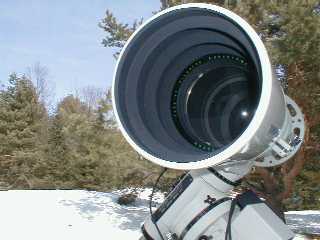 Massive baffles line the dew shield
The FCT does not take standard Takahashi finder brackets. Instead, there's a
cast iron ring near the back of the scope that's been drilled for special adapters.
You can mount one finder, two finders, eight finders, three finders and two cameras,
four finders and a guidescope and an FC60, whatever strikes your fancy. I liked
this feature. The massive dew shield has three very serious-looking baffles in it.
But don't drop it; the replacement cost of the dew shield might exceed the price
of many complete telescope rigs out there.
I used the scope over several nights in March of 2001. I figured out a way to
couple the scope with Meade's LXD750, but mostly wound up using it with the
AP900, which proved to be excellent match for the tube. By the way, hoisting
this 50 lb telescope up to shoulder height above solid pavement will quicken
your pulse for a few moments. We did eventually get the scope converted for
use on the Losmandy Universal Dovetail Plate, but it still scared me whenever
I had to mount it. Upon mounting it the first night, three of us still had the scope
cradled in our arms, even after we all knew it was securely attached. We must
have looked like the Three Stooges in the dark. No one wanted to be the first
one to let go, just in case.
Massive baffles line the dew shield
The FCT does not take standard Takahashi finder brackets. Instead, there's a
cast iron ring near the back of the scope that's been drilled for special adapters.
You can mount one finder, two finders, eight finders, three finders and two cameras,
four finders and a guidescope and an FC60, whatever strikes your fancy. I liked
this feature. The massive dew shield has three very serious-looking baffles in it.
But don't drop it; the replacement cost of the dew shield might exceed the price
of many complete telescope rigs out there.
I used the scope over several nights in March of 2001. I figured out a way to
couple the scope with Meade's LXD750, but mostly wound up using it with the
AP900, which proved to be excellent match for the tube. By the way, hoisting
this 50 lb telescope up to shoulder height above solid pavement will quicken
your pulse for a few moments. We did eventually get the scope converted for
use on the Losmandy Universal Dovetail Plate, but it still scared me whenever
I had to mount it. Upon mounting it the first night, three of us still had the scope
cradled in our arms, even after we all knew it was securely attached. We must
have looked like the Three Stooges in the dark. No one wanted to be the first
one to let go, just in case.
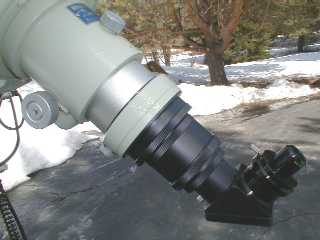 Detail on the 4" focuser
The FCT has an incredible star test. I saw no spherical aberration until we
pumped the power up to about 600X, which is superb. No false color was detected.
Even under modest seeing conditions, ten belts on Jupiter were clearly detected.
Under steady skies, Cassini's Division can be seen all the way around Saturn.
Like any great telescope, the FCT150 soaks up high magnification. Under good
conditions, it seems to ask you to pump up the power. Its contrast was excellent,
with even the dimmer, low-contrast objects like the more obscure galaxies in the
Virgo Cluster standing out clearly against the black background. For the first
time, I thought the mightly AP155 had a reason to be scared, and I called club
member David S to bring the AP over (Comparo coming up.)
After running initial tests, I just enjoyed myself looking at familiar objects. I did
a winter Messier tour and split some doubles in the area. The Eskimo looked
great, with plenty of mottled detail, at 147X. M35/NGC2158 and M38/NGC1907
were like diamonds on velvet, with the smaller companion clusters resolved even
at low power. There were a number of us present (I suddenly become a popular
guy around here when I have nice telescope to test) and every time I would
announce that I had something in the FCT150, a small crowd would gather
around the scope.
One problem I found was in the scope's focus travel. The Japanese do not
generally use diagonals, so their OTAs are often "longer" than the ones we
make here in the US. With a 2" diagonal in place, the focus plane was less
than half an inch from the visual back. I was unable to find focus at all when
a barlow was used. If you like to use high power -and this scope can certainly
handle it- you might want to invest in a TeleVue Powermate, which does not
affect the focus position.
I used this telescope every chance I had. I even set it up twice during cloudy
nights, hoping it would clear. I looked at everything I could think of, and then
went to my star atlases when I ran out of stuff in my head. It's a real joy to use,
a transparent window into the sky above. My only complaint about the FCT150
was that there wasn't more of it - someone want to loan me their FCT200??
Detail on the 4" focuser
The FCT has an incredible star test. I saw no spherical aberration until we
pumped the power up to about 600X, which is superb. No false color was detected.
Even under modest seeing conditions, ten belts on Jupiter were clearly detected.
Under steady skies, Cassini's Division can be seen all the way around Saturn.
Like any great telescope, the FCT150 soaks up high magnification. Under good
conditions, it seems to ask you to pump up the power. Its contrast was excellent,
with even the dimmer, low-contrast objects like the more obscure galaxies in the
Virgo Cluster standing out clearly against the black background. For the first
time, I thought the mightly AP155 had a reason to be scared, and I called club
member David S to bring the AP over (Comparo coming up.)
After running initial tests, I just enjoyed myself looking at familiar objects. I did
a winter Messier tour and split some doubles in the area. The Eskimo looked
great, with plenty of mottled detail, at 147X. M35/NGC2158 and M38/NGC1907
were like diamonds on velvet, with the smaller companion clusters resolved even
at low power. There were a number of us present (I suddenly become a popular
guy around here when I have nice telescope to test) and every time I would
announce that I had something in the FCT150, a small crowd would gather
around the scope.
One problem I found was in the scope's focus travel. The Japanese do not
generally use diagonals, so their OTAs are often "longer" than the ones we
make here in the US. With a 2" diagonal in place, the focus plane was less
than half an inch from the visual back. I was unable to find focus at all when
a barlow was used. If you like to use high power -and this scope can certainly
handle it- you might want to invest in a TeleVue Powermate, which does not
affect the focus position.
I used this telescope every chance I had. I even set it up twice during cloudy
nights, hoping it would clear. I looked at everything I could think of, and then
went to my star atlases when I ran out of stuff in my head. It's a real joy to use,
a transparent window into the sky above. My only complaint about the FCT150
was that there wasn't more of it - someone want to loan me their FCT200??
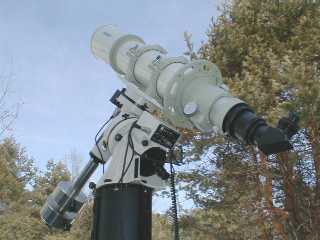 It's a beauty...
The night the scope had to go to its rightful owner was a sad one indeed.
I took the scope off the AP900 for the last time, wrapped it in warm blankets,
and seated-belted it into the back of my car. While there are some well-heeled
astronomers out there who would call $18,000 a bargain for a telescope like
this, I am resigned to the fact that I will, in all likelihood, never be able to
own one.
So call me one of the dreamers...
(Coming up: Super Duper Comparo - AP155, Tak FCT150, 178ED, and 7" Oak Classic!)
4) Megrez 80 4/06/01
(80 mm f/6 refractor, OTA, rings, case, diagonal, 25 mm Plossl, $649)
Here's another attempt to improve on the standard-issue inexpensive refractor
by wrapping the optics in one of William Yang's outstanding mechanical tube
assemblies. It sounds almost too good to be true - the mechanics alone are
worth $649. Wait'll you feel the smoothness of the rotatable focuser, or see
the precision of the machining on the visual back and the hefty rings. I was
tempted to recommend this telescope right out of the box, without even having
looked through it.
It's a beauty...
The night the scope had to go to its rightful owner was a sad one indeed.
I took the scope off the AP900 for the last time, wrapped it in warm blankets,
and seated-belted it into the back of my car. While there are some well-heeled
astronomers out there who would call $18,000 a bargain for a telescope like
this, I am resigned to the fact that I will, in all likelihood, never be able to
own one.
So call me one of the dreamers...
(Coming up: Super Duper Comparo - AP155, Tak FCT150, 178ED, and 7" Oak Classic!)
4) Megrez 80 4/06/01
(80 mm f/6 refractor, OTA, rings, case, diagonal, 25 mm Plossl, $649)
Here's another attempt to improve on the standard-issue inexpensive refractor
by wrapping the optics in one of William Yang's outstanding mechanical tube
assemblies. It sounds almost too good to be true - the mechanics alone are
worth $649. Wait'll you feel the smoothness of the rotatable focuser, or see
the precision of the machining on the visual back and the hefty rings. I was
tempted to recommend this telescope right out of the box, without even having
looked through it.
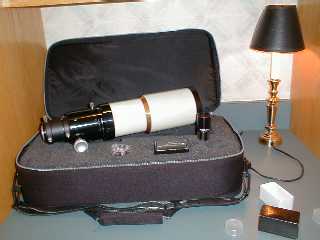 The 80 mm Megrez in its case
The scope looks a lot bigger and heavier in photos than it is in real life.
Weighing between 4 and 7 lbs depending on how you set it up, the scope
will easily fit on a photo tripod using only one of the rings. A Bogen 3001
should be more than enough. There's no provision for a finder, although you
might be able to fashion something using a one-power unit, or by mounting
something via one of the tapped holes on top of the rings. The case is very
well done too, with custom fitted foam (no little die cut cubes to fall out.)
The generic Plossl is of OK quality. The diagonal is a 1.25" erect-image
type, which you should think about tossing. Set yourself up with a nice 2"
diagonal instead.
The person who ordered this scope (available exclusively through Anacortes)
had it sent to his office. The telescope was so beautiful he spent the entire
afternoon playing with the focuser, sliding the dew shield in and out, etc.
When he brought it over here that night, it took only a few minutes before I
started doing the same thing. You really need to see and feel this scope,
it's so well-made.
I have been flooded with requests to review this telescope. It would seem that
you are getting a TeleVue Pronto class of instrument for about half the price.
What's more, it has slightly more aperture, two nice rings, and at least some of
us felt that the mechanics were even better than the Pronto's.
Initial star tests were mixed. The optics seemed astigmatic, with some spherical
aberration. Herb at Anacortes pointed out that some samples of these lens cells
have their retaining rings tightened down too far, resulting in pinched optics.
Loosening the retaining ring helped a lot. The optics on this one are decent,
with slight to modest false color around bright objects. Stopping down the
scope to 70 mm helped even more - stars were pinpoints all the way out to the
edge, very pleasing.
Views of the winter showpiece objects impressed my neighbor, who had never
looked through a telescope before. You can see NGC2158 near M35, and NGC
1907 near M38. M42 showed good extension, with all 4 Trapezium stars sharp
and easy to pick out. Jupiter had slight false color but decent detail in the
bands even at 68X. Saturn was sharp, with only a tiny trace of purple around
the ball of the planet.
I get a lot of mail from Megrez owners out there, and it seems there is some
variability in these optics. NO ONE disputes the excellence of the mechanical
assembly, however. Anacortes reports that some early units had problems with
their baffles (all of the current units in stock are said to be free of this problem.)
Among owners, the response (gauged from the mail) seems generously positive,
85%, say, with only a few dissenting voices out there. Anacortes does seem
reponsive to complaints, and they have a generous return policy so your risk
is not great.
Competition? The 80 mm Stellarvue has more consistent optics and is cheaper,
but doesn't have the Megrez's outstanding mechanics. Prontos are also very
good, very consistent, but they cost a lot for what you get. The "Short Tube"
units don't really compete in this league, although they are OK for casual
use, or for people on an extreme budget.
All in all, despite some minor grumbles about the QC in the optics, a very
impressive package. Recommended.
End Telescope Reviews, Page 15
The 80 mm Megrez in its case
The scope looks a lot bigger and heavier in photos than it is in real life.
Weighing between 4 and 7 lbs depending on how you set it up, the scope
will easily fit on a photo tripod using only one of the rings. A Bogen 3001
should be more than enough. There's no provision for a finder, although you
might be able to fashion something using a one-power unit, or by mounting
something via one of the tapped holes on top of the rings. The case is very
well done too, with custom fitted foam (no little die cut cubes to fall out.)
The generic Plossl is of OK quality. The diagonal is a 1.25" erect-image
type, which you should think about tossing. Set yourself up with a nice 2"
diagonal instead.
The person who ordered this scope (available exclusively through Anacortes)
had it sent to his office. The telescope was so beautiful he spent the entire
afternoon playing with the focuser, sliding the dew shield in and out, etc.
When he brought it over here that night, it took only a few minutes before I
started doing the same thing. You really need to see and feel this scope,
it's so well-made.
I have been flooded with requests to review this telescope. It would seem that
you are getting a TeleVue Pronto class of instrument for about half the price.
What's more, it has slightly more aperture, two nice rings, and at least some of
us felt that the mechanics were even better than the Pronto's.
Initial star tests were mixed. The optics seemed astigmatic, with some spherical
aberration. Herb at Anacortes pointed out that some samples of these lens cells
have their retaining rings tightened down too far, resulting in pinched optics.
Loosening the retaining ring helped a lot. The optics on this one are decent,
with slight to modest false color around bright objects. Stopping down the
scope to 70 mm helped even more - stars were pinpoints all the way out to the
edge, very pleasing.
Views of the winter showpiece objects impressed my neighbor, who had never
looked through a telescope before. You can see NGC2158 near M35, and NGC
1907 near M38. M42 showed good extension, with all 4 Trapezium stars sharp
and easy to pick out. Jupiter had slight false color but decent detail in the
bands even at 68X. Saturn was sharp, with only a tiny trace of purple around
the ball of the planet.
I get a lot of mail from Megrez owners out there, and it seems there is some
variability in these optics. NO ONE disputes the excellence of the mechanical
assembly, however. Anacortes reports that some early units had problems with
their baffles (all of the current units in stock are said to be free of this problem.)
Among owners, the response (gauged from the mail) seems generously positive,
85%, say, with only a few dissenting voices out there. Anacortes does seem
reponsive to complaints, and they have a generous return policy so your risk
is not great.
Competition? The 80 mm Stellarvue has more consistent optics and is cheaper,
but doesn't have the Megrez's outstanding mechanics. Prontos are also very
good, very consistent, but they cost a lot for what you get. The "Short Tube"
units don't really compete in this league, although they are OK for casual
use, or for people on an extreme budget.
All in all, despite some minor grumbles about the QC in the optics, a very
impressive package. Recommended.
End Telescope Reviews, Page 15
Back to Home Page
 Another impressive entry within
the EL line: Starmaster's 12.5"
Another impressive entry within
the EL line: Starmaster's 12.5" Celestron's new G8N
Celestron's new G8N Don't tell your wife how much it costs:
Takahashi's magnificent FCT150
(Mount: AP900)
Don't tell your wife how much it costs:
Takahashi's magnificent FCT150
(Mount: AP900) Massive baffles line the dew shield
Massive baffles line the dew shield Detail on the 4" focuser
Detail on the 4" focuser It's a beauty...
It's a beauty... The 80 mm Megrez in its case
The 80 mm Megrez in its case